Canaway Downs Station, QLD. Friday 12th May 2017
Australia’s cattle stations can be pretty damn big. How about over 23,000 square kilometres (9,000 sq miles)? That’s bigger than some countries. In fact that particular one is the biggest in the world. Queensland’s biggest is ‘only’ 15,100 sq kms (5,800 sq miles). In early settlement days they used to talk about how so-and-so’s front gate was fifty miles from their front door. So Canaway Downs isn’t very big by comparison, at 9,30 sq kms. But it’s worth remembering that it’s a family owned business whereas the large ones are usually owned by big companies.
It was nowhere near fifty miles from the gate to the door. I don’t think it was even that far from Quilpie, the nearest town. But when I arrived I was made welcome by Jody and three of her four kids. Her husband, Gerard, manages the station and he and Scott were out working somewhere. Jordan was there too. She’s the kids governess, for want of a better word. The older two boys ‘attend’ the School of the Air and it’s Jordan’s job to help them do their work. Tim is nearly ten so will go to boarding school when the next school year begins in December. Then Oscar will be joined by Sam, who’ll be old enough to start school. I was surprised to learn that the school day is from 7.30 to 3.30,with regular contact with school teachers over the satellite link. Eventually the others returned, along with Stuart and Clint. Stuart is a fencing contractor and had been working there for nearly a year. He also has his own, smaller, station. Clint had recently joined the crew as a general labourer.

Scott and me.
After a very nice meal we went over to the other house, just across the way, where all we visitors were staying. That included Scott, which struck me as odd at first, considering he owns the place. But of course he isn’t there much of the time and the homestead is occupied by Gerard, Jody and their kids. Most stations have extra accommodation, to house itinerant workers such as musterers. It was certainly comfortable enough, with wi-fi and an esky full of beer.
I was alarmed by how early the alarm call was! I’m not used to getting up in the dark. But the breakfast we had over at the main house was worth it and I’d made it clear to Scott that I wanted to join them out on the fence line and help wherever I could. The work had about two or three weeks left to go. Maybe I’d better explain what’s happening.
Scott, along with the owners of two neighbouring stations, decided to install a kangaroo and dog proof fence around the perimeter of the three properties. The aim is to keep kangaroos, dingos and wild dogs off their land so they can start to run sheep again. At the moment they only run cattle, 2,500 head in Scott’s case. The problem with kangaroos is that they are in competition with the sheep for the same food. The problem with the dogs is that they kill sheep for fun. They attack a sheep, tear its throat out then just leave it there and go to find another one. A dog could kill up to two hundred sheep in one night. Not for food but just because they can.
The fencing is very strong and the bottom part is laid flat on the ground so that dogs can’t dig under it. It’s 1.8 metres tall so even a kangaroo can’t jump over it. The job is nearly finished and has taken over one year. It’s expensive to do but fortunately the QLD government provide a grant because they are keen to see more sheep being raised. They’re more labour intensive, which has the effect of boosting the economy in small outback towns. Having seen the way sheep shearers can drink, down in Tibooburra, I can understand what they mean. The state grant will cover around half the cost of the materials required. The stations will cover the rest. The fence will also help prevent the spread of diseases. Gerard told me that about five years ago their cattle suffered an infection which was spread by saliva, and eliminating it cost over $250,000. “But won’t there be loads of ‘roos trapped inside the fence” I asked? “Yes” was the answer “but we’ll cull them by about two thirds and they’ll go for meat.” “How many are there” I asked? “Around 50-60,000,” said Gerard. That’s a lot of meat. And a lot of shooting. It occurred to me that the baker down at Birdsville could be making pies forever more with that lot.

The mesh is small, so kangaroos can’t get through it, and the bottom of the fence is flat on the ground to prevent digging.
The others headed off in the Ute but Gerard decided to take the plane and I went with him. Now, this was definitely novel, for me at least. I know that many stations are so big that planes are essential for getting around, and given that it took nearly an hour to get to the work site by road it’s easy to see why. Some places even use them for mustering, although small helicopters are more popular. Gerard’s plane is tiny but there was room for two, although I needed to keep my knees and arms clear of the duplicate set of controls. He showed me around a bit on the way out, pointing out some of the key infrastructure, which I’ll return to later.

Gerard is tall, the plane is tiny.
Scott came out to meet us when we landed and I was immediately set to work driving the light truck, which was the work platform from which the fence posts were driven into the ground. There was a compressor on the back of the truck which powered an air hammer, along with stacks of galvanised steel posts. Clint would hold a post upright at the right spot, Scott would stand on the back of the truck and hold the hammer over the post, so as to drive it down to the correct level, then I’d drive forward ten metres and we’d do it all over again. One hundred fence posts per kilometre, times one hundred and thirty kilometres. Work it out, and then don’t be surprised that the job’s taken a year to complete.
Meanwhile Gerard and Stuart were concreting 100mm diameter steel tubes into the ground at various places. They are about two metres high and are used to provide support to the fencing mesh when it’s tensioned. Some would also support gates. They are strengthened with diagonal supports and these, and the gate hinges, are welded on. I was very impressed by the welder, which has a built in petrol powered generator and can therefore provide power for other tools too. I added that to my list of ‘things I’d like to have in my garage’.
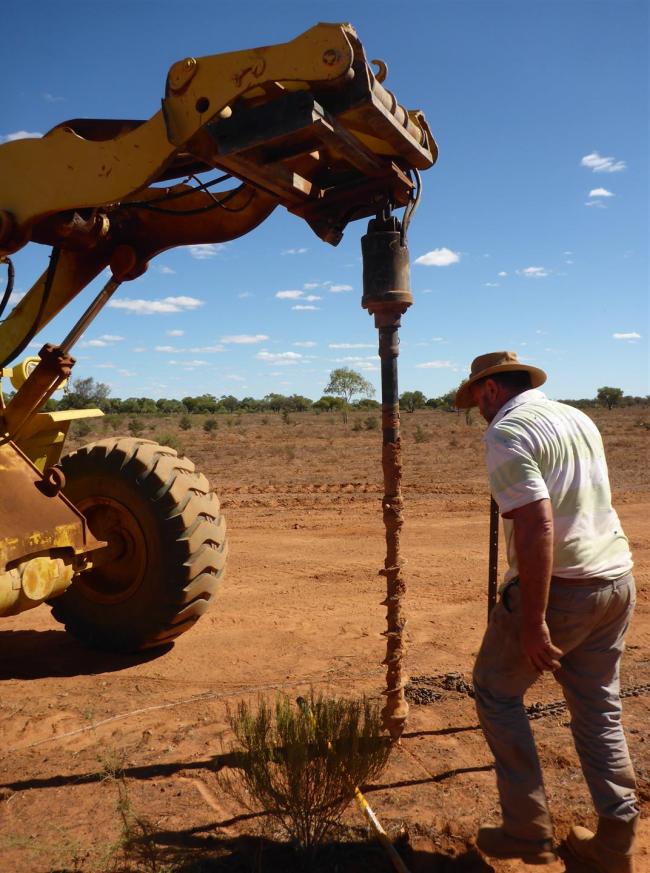
Drilling holes with an auger, ready to concrete in some fence posts.
The mesh itself comes in rolls of 250 metres and these were kept on the back of one of the three semi-trailers I’d seen in use around the station, hauled by a very old Mack prime mover. A steel tube was inserted into the centre of the roll, which was then pushed into a cradle at the back end of the trailer. Once the new roll had been linked to the old one, using special crimps, the truck was simply driven forward and the mesh laid itself out on the ground, ready to be hooked onto the fencing posts. At intervals we’d come to one of the strong steel tube uprights. At this point a special plate was attached across the mesh, a chain was attached to the plate and was pulled forward, usually using the loader (bulldozer) until there was enough tension in it. The mesh was then cut and wound around the steel post to secure it. Then it all began again.
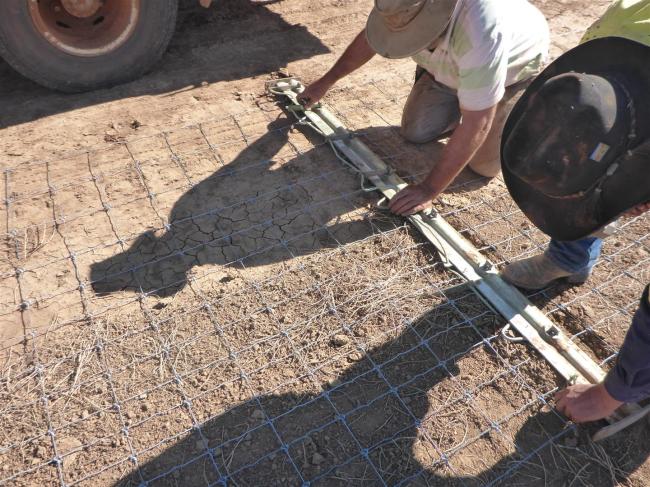
Attach chains to this spreader plate and put tension into the fencing. Then tie it off and start again.
Over the five days I was there I spent four of them helping with this huge task. I can’t say that I made any significant contribution but at least I can claim that lots of my sweat, and a few drops of my blood, have been left behind on a station in Queensland which is now in marginally better shape that it was before I arrived.
At one point Scott and I were driving along a track when we saw a kangaroo that had tried to get through one of the other fences and had got its rear legs twisted into the wire. We freed it and left it there to see if it would recover. When we came back some hours later it was still lying where we’d left it, clearly unable to move. No option other than to put it out of its misery, sadly, which Clint did with a the lump hammer. Another casualty of animal and human interaction.

We’d have been delighted it it had hppped off once we’d freed its legs, but it didn’t.
Scott’s mother, Betsy, came to visit, bringing her partner Barney with her. She now lives in Toowoomba but used to live on the station before Scott’s dad died. Barney owns a vineyard down in South Australia but originally came from the Caribbean island of St Vincent. He’s white and he told me that most white Caribbeans used to be convicts. So I guess he felt right at home in Australia then! Betsy had plenty of tales of the days when she used to help with mustering on her motorbike and she clearly still takes an interest in the station. I’d guess that she’s still a partner in the business.
One morning we all drove out to look at some Aboriginal cave paintings that Scott had come across some time ago. He’d photographed them and sent the pictures to some experts but they couldn’t really make much of them. As the photos show, they’re not really pictorially interesting, except that they’re likely to be hundreds or thousands of years old. Clint is part Aboriginal and was clearly quite moved by them. He said he’d never forget this day as long as he lived and planned to see if his grandfather might have any knowledge of them. They were hidden under an overhang of rock, at a cliff face, which seems to be quite common. Places of this kind were regular meeting venues.
So after that bit of culture it was back to the fencing, which Betsy and Barney were delighted to join in with. Extra hands were welcome as Stuart had now gone off to do other work anyway.
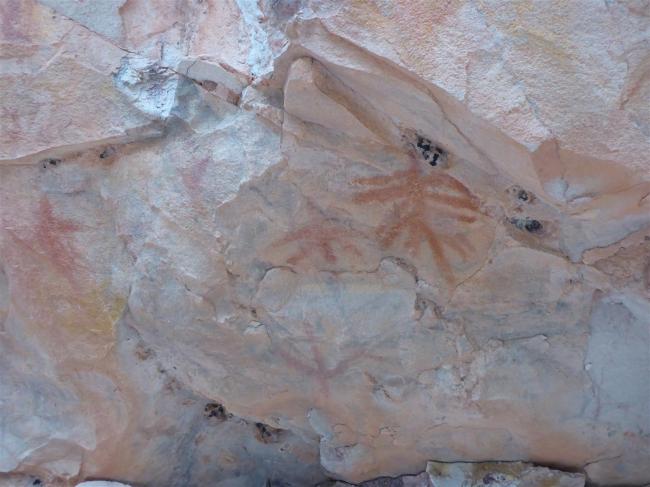
What do they mean? Nobody knows.
That evening Scott took me, Betsy and Barney up to look at the opal mine on his property. There are several ‘jump ups’ on his land and one of them turned out to be quite rich in usable opals. It seems that they were discovered many years ago and the mine was owned by a businessman from Brisbane. The tops of these hills are flat and this guy had an airstrip laid out so that he could fly out to his mine from the city. But no mining had taken place for the last seventeen years. Why? Well the state mining commission demands that mine workings are not allowed to spread further than the designated area and also that reinstatements must be made once an area is mined out. The mining company failed to meet both these obligations so was ordered to cease activity. They either couldn’t or wouldn’t undertake the the work. Scott said they’d tried to dodge paying for their licences, which had piqued the interest of the commission, with the results described. Serves them right really.

We were sitting on the other side of this gap, where the hill has been torn away in the search for opals. It’s a mess!
I was amazed to learn that Scott, as land owner, gets next to nothing from the mining operation. There will be a compensation payment made at the start of operations but it isn’t much and there’s no commission payment or profit share to follow. It seems that he owns what’s on top of the land but not what’s underneath it. That means that any prospector can walk onto more or less any land and if they find evidence of valuable minerals they simply peg out a claim. Then they take their evidence to the mining commission and buy a licence from the state government. Then digging begins, however the land owner might feel about it. So we watched the sunset from the top of the hill, mused over the injustices of these things while we drank beer, then walked back down to the Ute and drove home.

It was quite a nice sunset through the rain clouds at least.
In the morning Scott took Barney and me up in his plane for a look around the property. It was mostly for Barney’s benefit as I’d seen at least some of it before. Scott’s plane is a four seater and I was surprised when he told us it’s fifty years old. It’s very obviously more sophisticated than Gerard’s, and is clearly better suited to the longer distances that Scott tends to cover. But it’s age does at least explain the ‘Morris Minor’ look to the cabin.
One of the key pieces of infrastructure on any outback station is the borehole. A large part of Australia sits above the Great Artesian Basin, and towns and stations have been digging boreholes into this essential water supply since the mid 19th century. But there is a problem with this. Many old boreholes have been abandoned but still have water pouring out. In the early days it was assumed that this water came from annual rain which worked its way down through the rock and was therefore being constantly replenished. Like a giant storage tank. Later studies showed this to be incorrect. The water isn’t from the last wet, the last century or even the last millennia. It’s tens of thousands of years old and once it’s been used will take a similar time to replace. So it needs to be conserved. For this reason Queensland are providing grants to landowners so they can block the old, inefficient bores and drill new ones, to be used far more efficiently. In Scott’s case a 1.7 kilometre bore was dug – twice. The contractors messed up the first one so it had to be done again. Gerard told me the water comes out at 90 degrees and at a pressure of 160psi. Next to the bore head is a dam (a large pond, raised off the ground), and beneath the three metres of water is a giant heat exchanger, designed to cool the water down before it’s dispersed around the whole property. Gerard used Google Earth to design the pipe layout, all 160 kilometres of it! There are several dams around the station so all stock have access to water, wherever they are. It also supplies the homestead but as it’s a little sulphourous tends not to be used for drinking. Rainwater is collected for that purpose. I was fascinated by the whole geological story of the artesian basin but I won’t ‘bore’ you with it here. Follow this link to find out more. http://www.gabpg.org.au/great-artesian-basin

The dam has the heat exchanger at the bottom but also allows stock to drink.
Time to move on from Canaway Downs. Five days of experiencing station life, working for my keep and learning a huge amount about this extremely important part of the Australian economy. I was heading across country a bit, not too far though, to meet up with Grace, who was working at a different station. We’d been chatting by email and I was keen to meet a fellow traveller who, judging by her writing, had another viewpoint to add to what it was all about. So after saying goodbye to Scott and the others, I set off.
A three hour dirt road ride found me at Navarra, where I met Andy, the station owner, and Grace, currently working as his offsider (general helper). As well as running the station Andy also has a business supplying solar powered pumps to stations and other facilities. Andy’s property is ‘only’ 60,000 acres and he runs sheep. Currently only 1,000 although he could go up to 5,000, but it’s been too dry to support that number. It seems that the bulk of his work comes from his pump installation business. As with Stuart, the fencing contractor I met at Canaway Downs, I get the impression that owners of smaller station will combine that business with another. Having said that, it was shearing time so mustering and organising the shearers was likely to keep Andy and Grace away from solar pumps for a while.

The welcoming committee.
Grace and I seemed to hit it off very well. She’s in her late twenties, studied then worked as a lawyer before she started her trip, and has ridden to many parts of Australia.We had a long talk one evening and she told me about the bike problems she’s currently having. It seems that her bike Beastie is being beastly. She rides a KTM690 Enduro and has been having starting problems. She managed to get it to a bike shop not too far from Navarra but it still isn’t right. “It starts eight times out of ten” the shop said. I wouldn’t have been happy with that and neither was Grace. If you’ve read her blog (www.bikehedonia.wordpress.com) then you’ll know that she prefers to camp in out of the way places and that means no help to call on when numbers nine and ten come to visit. Grace has made plans to get Beastie to a place where it will eventually get sorted out, which she’ll follow through with in due course.
Grace and I had a long talk one evening. We offered our stories to each other, chatted them back and forth, and realised that despite our differences in age, gender and starting point, we had much in common with regard to what we want from our travels. I feel that only long distance travellers can truly understand the mindset of one another. Add in the problem of maintaining a motorcycle and you have a unique combination of risk and reward. Our talk helped me to understand better what I’m doing and reinforced in my mind how much I like it.
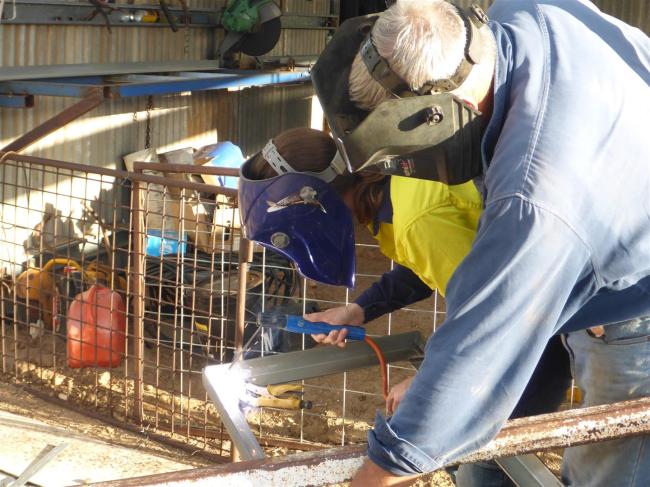
Grace takes the opportunity to improve her welding skills.
But Grace has another side to her journey. Compare these two phrases that an unthinking commentator might apply to each of us: “Middle aged man decides to explore the world on his motorbike”; “Crazy young woman risks life and limb by riding across the world”. That summarises the one thing that Grace has had to deal with which would never affect me. It’s very unfair, and Grace had to fight battles even before she started. Fortunately she has good friends who support what she’s doing. I was happy to tell her that I follow three blogs, including hers, and the other two are also written by women who are doing the same as she is. I admire her determination to overcome the negativity as well as all the ‘normal’ problems too.
Meanwhile it had started raining – hard! Hard enough to cause the electricity to cut out after a while. Fortunately Andy had a generator, no surprise there considering the remote location. But I was surprised when, having been conscious of rainfall throughout the night, Andy checked the rain gauge and there was only 18mm. Andy was on the phone half the morning, talking to his neighbours and swapping information about the contents of their gauges. What surprised me was how great a variation there is between areas that, to me at least, don’t seem very far apart. His mother’s station, which I’d ridden through on the way from Canaway downs, is only about 100kms away and had 26mm. All this concern reinforced to me how important rainfall is in the outback. But little though it was, it did stop us from having a night out at the local pub. The nearby town of Yarraka has a pub where the landlord is renowned for his ability to take the mickey out of his customers while taking the money from their pockets. There’s often music too. So we set off but at the first creek crossing Andy looked at the depth board, with the water level at 400mm, and said “This is as far as we go”. I suggested that the Ute should get through that quite easily and Andy agreed. But he said the next crossing will be at least a metre deep and the water was still rising. Oh well, Saturday night out cancelled. Just the beer in the fridge to rely on.

The creek was rising so we weren’t going out.
One morning I asked Andy if he had any offcuts of steel tubing hiding in his gash bin. Uproars of laughter from him and Grace. They’ve never heard the word used that way before, to mean offcuts and odds and sods, put to one side for future use. It seems to have a completely different, and far less innocent, meaning in Australia. But once the laughter had died down Andy found me a length of tubing that I could use to support my luggage racks. The idea is to quell all the vibrations which will inevitably cause steel tubes to fracture. One side already had and had been welded up by Jock at Handlebar Haven. My plan was to borrow some tools and make the support brace myself but Andy, bless him, simply got on and did the job for me. And once some paint was added later, it looked pretty good.

Linking the luggage racks together adds support against the dreaded vibrations.
Being, as I am, someone who likes to get involved in new things, and to help out when I can, I will tell you quickly about two such things. The first is mustering, a whole new experience for me. Grace and I rode down to one of the nearby paddocks to bring a small flock of sheep back to the homestead. Andy wanted to select one of them to use to restock the freezer. Now this was going to be a real new experience, watching a sheep being turned into mutton. But it wasn’t to be. We managed to round them up and get them down near the open gate, with Grace herding them and me off to one side, very much under Grace’s command. But I think I must have got too close because they suddenly spooked and ran back up the paddock. I went chasing after them and managed to get them heading back in the right direction, but Grace said to forget it. The sheep were now too stressed to be killed. It seems that a stressed animal supplies tough meat. So it was left for another day.
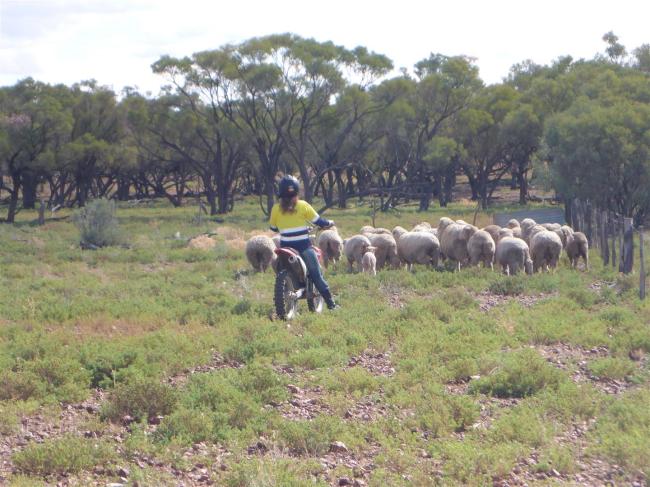
Mustering sheep, with all mod cons.
I was much better at the second task, where we went down to the shearers’ quarters and gave the place a spring clean. The accommodation is very basic. A wooden building with iron bedsteads in the rooms, with foam mattresses on top of the bedsprings. A very basic kitchen and dining area and an ablution block across the way where the water is heated by a wood fire burning underneath the tank. I had the impression it hadn’t changed much in decades but the shearers would only be there a few days and their temporary home would be comfortable and clean.
By the time I left Navarra, very happy to have met Grace and Andy, my journey up the learning curve relating to station life had advanced a little further. I know that Grace was way out in front of me, feeding her desire to learn new skills and gain new experiences. Her journey will continue in due course, once she’s ready to press the starter button, do up her crash helmet and head off up the road. I wish her bon voyage and bon chance, in exactly the same way other people have wished it for me. I will add one thing – Grace makes a pretty mean sticky date pudding!

Grace and Andy.
Meanwhile it was time for me to be a tourist once more. I had many places circled on my map, where people had said “You must go here” or “You must go there”. So I figured I’d better start moving along.

Another great posting, Geoff! Unfortunately, I think I can guess the Aussie usage of that word! ;o) David
LikeLike
Thanks David, and I think you’re probably right.
LikeLike
Yet another great account of your adventures Geoff,thank you.
LikeLike
Thanks Bob. I’m pleased you’re enjoying it.
LikeLike